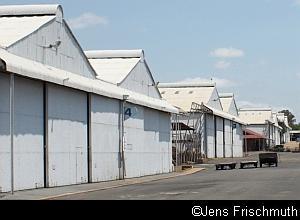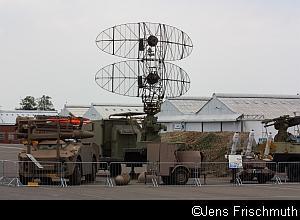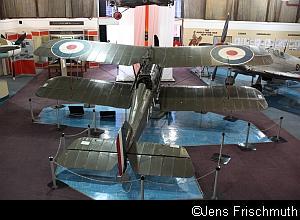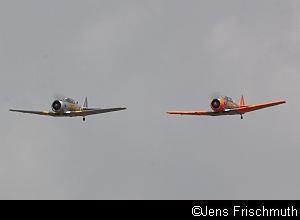South African Air Force Museum, AFB Swartkop
Established in 1973 with
the purpose of preserving the South African Air Force's rich aviation history, the SAAF museum has accumulated
an impressive collection of over 150 complete aircraft and many more aircraft
parts over the 35 years of its existence. The majority of the
collection is housed at the main Museum at Air Force Base
Swartkop. Satellite branches exist at AFB Ysterplaat in Cape Town and at AFS Port
Elizabeth. Fittingly, the museum is situated at
the site that was the South African Air
Force's first and for a long time only airfield. The fledgling SAAF took over the airfield in April
1921, a year after it was founded in 1920.
Fittingly, the museum is situated at
the site that was the South African Air
Force's first and for a long time only airfield. The fledgling SAAF took over the airfield in April
1921, a year after it was founded in 1920.
Today, the
Museum occupies the six Northern hangars
at Swartkop and most of the surrounding buildings. The hangars are the original
ones built in the 1920s and are of historic significance
themselves. Besides
preserving historic aircraft, the Museum collects and preserves other
aviation-related items such as fire fighting vehicles and equipment, petrol
browzers, radar and radio equipment, missile defence systems and
security equipment. The Museum has a sizable collection of photos and
logbooks and other valuable memorabilia. It strives to collate and document
the history of the Air Force so that it can be preserved for future
generations.
Besides
preserving historic aircraft, the Museum collects and preserves other
aviation-related items such as fire fighting vehicles and equipment, petrol
browzers, radar and radio equipment, missile defence systems and
security equipment. The Museum has a sizable collection of photos and
logbooks and other valuable memorabilia. It strives to collate and document
the history of the Air Force so that it can be preserved for future
generations.
 Sadly, much of South
Africa's early aviation history was lost as there was no concerted effort to
preserve specimen in the early days. The first museum that
preserved aircraft was the South African National Museum of
Military History, which was opened in 1947. Its collection from the early
days includes three complete World War I era aircraft (including the SE.5a, pictured right), as well as seven World
War II era aircraft.
Sadly, much of South
Africa's early aviation history was lost as there was no concerted effort to
preserve specimen in the early days. The first museum that
preserved aircraft was the South African National Museum of
Military History, which was opened in 1947. Its collection from the early
days includes three complete World War I era aircraft (including the SE.5a, pictured right), as well as seven World
War II era aircraft.
It took until 1973 before the SAAF
got its own Museum. The driving force behind its establishment was
Col. Peter McGregor. Had the museum been established a few decades earlier, a
lot of priceless planes could have been saved from scrap yards and the
gradual decay of the elements. From then on, at least, examples of aircraft
types retired from service would be preserved for future generations. Because
of the late start, the majority of the collection portrays the most recent
part of the SAAF's history.
The
first aircraft received by the museum was a Lockheed PV-1
Ventura, and
the first planes acquired by the Museum were housed
at AFS Snake Valley, where the Museum got the use of half of No. 13 Hangar
in November 1973. The Museum moved to Lanseria Airport when the Museum
was given notice to vacate the Snake Valley hangar in August 1976. By
the end of the 1970s, its collection included a Fieseler Storch, Spitfire IXe, Beech C-45,
Sikorsky S-55, Percival P40 Prentice, Canadair Sabre, de Havilland Tiger
Moth and three Vampires, as well as numerous incomplete airframes.
From the early 1980's, part of the growing collection started
to arrive at Swartkop and part of the Museum was back in Hangars 9 and 14
at Snake Valley. Gradually, the original six hangars North of the control
tower at AFB Swartkop were vacated and handed over to the Museum. The
1980s also saw the establishment of satellite branches at AFB Ysterplaat in
Cape Town and AFS Port Elizabeth and saw the establishment of a civilian
support organisation, the Friends of the SAAF Museum, in Johannesburg.
Important acquisitions during the 1980s included a Percival Provost,
Airspeed Oxford and a North American P51D Mustang.

The
Defence Force's rationalisation
of the early 1990s brought many aircraft to the Museum, which
was now spread between Swartkop and Lanseria. These included Mirage IIIs
and F1s, Buccaneers, Canberras and
a Wasp, Super
Frelon, Douglas DC-4, Bosbok and Kudu each. The SAAF's relocation from
Lanseria in 1991 saw the last of the Museum exhibits transferred
to Swartkop and the unit was finally amalgamated when the SAAF
Museum was officially opened at the base on 15
May 1993. As part of the proceedings, a Transall C-160 was delivered by
28 Squadron and this was followed by a Dakota, Impala Mk I
and II, two Harvards and several Pumas.
The most recent acquisitions include a Boeing 707-328C,
two airworthy Alouette IIIs and three airworthy Impalas.
The Impalas, like the airworthy Mirages, are housed at AFB Hoedspruit and maintained
there on behalf of the Museum.
 Part of the Museum's task is to keep
flying examples of some of its historic planes and the Museum has undertaken
the painstaking task of restoring various aircraft to flying
condition. Often, restorations were done in conjunction with operational
squadrons.
Part of the Museum's task is to keep
flying examples of some of its historic planes and the Museum has undertaken
the painstaking task of restoring various aircraft to flying
condition. Often, restorations were done in conjunction with operational
squadrons.
Many of the restored planes are still in the air today, although some were lost because
of mishaps over the years - the Avro Shackleton Mk3 #1716 (Pelican 16) was
lost to the Saharan Desert after being forced to crash-land there in 1994
after suffering multiple engine failures, the Sikorsky S-55 was extensively damaged during
a forced landing at the South African National Museum of
Military History in 1995, the Spitfire was extensively damaged in 2000
at AFB Swartkop after crashing following an engine failure and the P-51
Mustang was damaged during an incident at AFB Waterkloof when its
undercarriage failed to lower in 2001.  At present, the museum maintains about
25 airworthy aircraft at AFB Swartkop. These include a couple of
Harvards, two Alouette IIs
and IIIs each, two
Vampires and Kudus, as well as a Canadair Sabre, Piaggio Albatross, Bosbok, Puma, De
Havilland Chipmunk and a C-47 Dakota. Many of these planes are flown
regularly at the Museum's monthly flying days and the Museum's aircraft participate in various
air shows throughout the year. Together with the few planes flying at
the satellite branches and the fast jets at AFB Hoedspruit, this is
the largest flying fleet of historic aircraft of any state funded Air Force
Museum in the world.
At present, the museum maintains about
25 airworthy aircraft at AFB Swartkop. These include a couple of
Harvards, two Alouette IIs
and IIIs each, two
Vampires and Kudus, as well as a Canadair Sabre, Piaggio Albatross, Bosbok, Puma, De
Havilland Chipmunk and a C-47 Dakota. Many of these planes are flown
regularly at the Museum's monthly flying days and the Museum's aircraft participate in various
air shows throughout the year. Together with the few planes flying at
the satellite branches and the fast jets at AFB Hoedspruit, this is
the largest flying fleet of historic aircraft of any state funded Air Force
Museum in the world.
Below
is
a photographic record of the majority of
the Museum's aircraft types.
More information on the
Museum, including visiting hours and directions on how to get to the museum, can be found at
the Museum' s official website, www.saafmuseum.co.za
.
"On Wings of Eagles" by Dave Becker, Walter-RamusTrading Co. SA (Pty) Ltd 1995
"SAAF Museum Yearbook 2007", SAAF Museum 2007
"Soaring with Eagles" by Frans Dely, AvPix Publishing 2004
"Squadrons of the South African Air Force and their Aircraft from 1920 - 2005" by Steven McLean, Interpak Books 2005
"The Eagles of Swartkop" by Dave Becker, Freeworld Publications 1996
